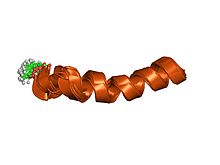Vpr is a Human immunodeficiency virus gene and protein product.[1][2] Vpr stands for "Viral Protein R". Vpr, a 96 amino acid 14-kDa protein, plays an important role in regulating nuclear import of the HIV-1 pre-integration complex, and is required for virus replication and enhanced gene expression from provirus in dividing or non-dividing cells such as T cells or macrophages.[3] Vpr also induces G2 cell cycle arrest and apoptosis in proliferating cells, which can result in immune dysfunction.[4][5]
| VPR | |||||||||
|---|---|---|---|---|---|---|---|---|---|
 solution structure of hiv-1 vpr (13-33) peptide in micells | |||||||||
| Identifiers | |||||||||
| Symbol | VPR | ||||||||
| Pfam | PF00522 | ||||||||
| InterPro | IPR000012 | ||||||||
| SCOP2 | 1dsk / SCOPe / SUPFAM | ||||||||
| TCDB | 1.A.42 | ||||||||
| |||||||||
Vpr is also immunosuppressive due to its ability to sequester a proinflammatory transcriptional activator in the cytoplasm. HIV-2 contains both a Vpr protein and a related (by sequence homology) Vpx protein (Viral Protein X). Two functions of Vpr in HIV-1 are split between Vpr and Vpx in HIV-2, with the HIV-2 Vpr protein inducing cell cycle arrest and the Vpx protein required for nuclear import.
Vpr-binding protein
Vpr-binding protein (VprBP) is a 1,507-amino-acid human protein that contains conserved domains, including YXXY repeats, the Lis homology motif, and WD40 repeats.[6] VprBP acts as a substrate-recognition unit when associated with DNA damage-binding protein 1 (DDB1) as part of a CUL4–DDB1 E3 ubiquitin ligase complex.[6] When bound to Vpr, VprBP allows Vpr to modulate the catalytic activity of the CUL4–DDB1 complex, inducing G2 cell cycle arrest in infected cells.[6]
VprBP also regulates p53-induced transcription and apoptotic pathways. p53 is an important tumor suppressor which induces either cell cycle arrest or apoptosis in response to DNA damage.[6]
In-vitro studies of Vpr
The lack of an in vitro cell culture system that demonstrated a deficit in replication upon infection with viruses in the absence of Vpr has led to some mystery in the function of Vpr. Recently, there has been experiments on monocyte-derived dendritic cells (MDDCs) using a novel in-vitro infection system. These infected human dendritic cells showed a slower rate of replication when deprived of the Vpr protein in HIV-1 cells. This replication difference occurred in a single round of infection. This was shown to be due to decreased transcriptional output from the integrated HIV viral genome. Using mutational analysis (biochemical identification of mutational changes in a nucleotide sequence), prevention of cell cycle progression into mitosis was shown to be required for LTR-mediated viral expression. These findings suggest that the evolutionarily secured G2 cell cycle arrest function of Vpr (Viral Protein R) is essential for HIV-1 replication. Furthermore, this innovative in-vitro culture system will allow researchers to address mechanisms underlying Vpr-mediated enhancement of HIV-1 replication.[7]